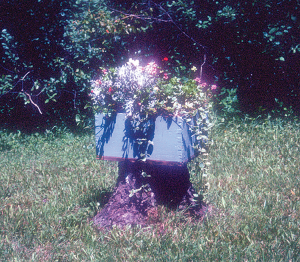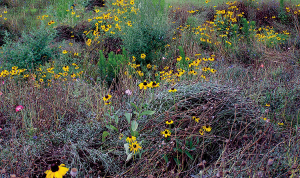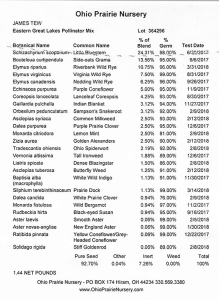By: James Tew
Flower gardening discussion and issues for the beekeeping non-gardener – that would include me, too.
My two bee worlds
I can already tell that this is going to be one of those articles. I have written three or four introductions and all are now wadded in my electronic trashcan. Essentially, this is what I want to discuss with you but I am not sure how to open. I want to put in wild flower plantings on my acre but I am not sure what I am doing.
I promise you that what follows is true – at this very moment, my neighbor is cutting his grass for the first cut of the season. The sound of a mower – somewhere near me – will go on until next November just before Thanksgiving. The 2018 mowing season is officially here in Wooster, Ohio.
As is true for all areas that have lawns, the technology for grass cutting has blossomed from the 22” Briggs & Stratton, 3 HP push-mower that I used in my youthful grass-cutting business. Like everyone else, I now climb upon my riding mower with hydraulics and power steering and hydraulic-assisted brakes and off I do go to beautify my lawn.
To run these machines, large expanses of open lawn – with few trees – is ideal. If you have read my myriad past articles on this lawn subject, you are painfully aware of my fixation on this lawn maintenance subject.
So what does mowing have to do with pollinator gardens?
All this standardized mowing that goes on in my manicured cul-de-sac community does not fit particularly well with raised pollinator gardens or flowering gardens that are anything but in full bloom. Those of you who do not live near other people who constantly care for their lawns and who do not have my irrational passion for bees may be hard pressed to understand my thread here. I don’t want to be “that guy” in the neighborhood who stands out, but I do want something besides a grass lawn.
If I may, could I break this topic into subject areas and discuss them individually? Otherwise, I sense that I will ramble to the point of oblivion – something I can do very well.
1. I want the flowering garden look that many of you already have.
I love flower garden photos of those backyards that have gravel paths with cast iron benches punctuated with bird waterers and bird boxes – and flowers and plants everywhere.
Presently, I have heavy Ohio soil that sticks to my boots until about the middle of June. I have crabgrass/cool season perennial fescue lawn mixed with white clover that I do not spray. It’s hardy ground cover on which my grandkids can romp and we can take tractor rides that leave lawn marks – but I don’t care. This scruffy back lawn is for play. But this is not the image of my perfect world. It’s too real – too practical – too sterile. How can I punctuate with flowers?
2. I simply cannot take on another major time/work commitment.
Whatever I do to develop flower plantings needs to be easy to do and not require significant amounts of reading time and work time. Additionally, it cannot require a meaningful amount of maintenance time. I hypothesize that easy lawn maintenance is why so many of us value manicured lawns. Get on the mower and go. I admit that I am presently very nearly within that group.
As do all of you who have read to this point, I have other aspects of life that compete for my waning energy. Writing this article, finding photos, developing ancillary electronic social media files and then editing everything will take about two days. And that’s just this article. There is always something that needs to be done. But I have no lock on this time excuse. We all could readily use more time. But I need to candidly say that if this flower garden project becomes too large, too demanding – I will fail. Right now, I struggle to keep my bee colonies going.
3. I’ve already tried this pollinator garden concept a few years ago.
I didn’t just come to town on a turnip truck. Several years ago, I bought seed and converted my small vegetable garden to a flowering garden. It was initially easy to do. I tilled as usual and shallowly strew a bee mix of flower seed suitable for Ohio.
As should be expected, all was bare ground for several weeks. In the bare, exposed soil, robin’s found the worm hunting to be very good. Rabbits sampled some of the young plants as they emerged. Ground hogs began to compete with the rabbits, but even with all of this salad consumption, the plants grew and prospered reasonably well. They flowered beautifully and the pollinators came as well as the Japanese beetles, stinkbugs and an assortment of other uninvited insects. Neighborly compliments flowed.
4. Then came the midsummer decline
By hot, midsummer some of these plants were giving it up. I was expecting this. Annual plants that were finishing seemed to start yellowing/browning from the bottom. The spent flowers needed deadheading. That’s not going to happen. There was a selection process whereby those plants that bloomed longer tried to sally on but the beautiful first flush was over. As Summer progressed, all became a brown jumble of dead/dying plants and encroaching weeds punctuated with a few desperate flowers. All the compliments stopped.
Should I have mowed those spent plants and planted Fall season blooming plants? Will these plants perpetuate themselves or need a boost of newly applied seeds next season? Or should I have just completely replanted?
5. I’m doing that thing I do
I’m unintentionally doing that thing I do – where I make things look too negative. Obviously flowering gardens are beautiful, and if in large quantity, highly beneficial to pollinators and attractive insects. I (and you) will need to expect other uninvited species to visit the plantings.
I will need to become more acceptant of a periodic scruffy look that such planting will – of necessity – exhibit. If I committed more time to the plantings, I could keep them looking nicer, but I would have to spend that time at the expense of other of life’s projects. My advice to myself is: do not start too large and while doing the best I can, do not expect perfection.
6. This is the mix that I have purchased (see the list).
The price of the seeds is not inconsequential. For me, the price of the seed would require that I put in enough time and effort to make this project a bit worthwhile.

Old photo converted from 35mm slide film. Deep super is upturned with repurposed inner cover tacked to the bottom. The plants are containerized. The flower box is attached to the stump.
7. Finally, for those with experience, could you offer suggestions?
In summary, I am a beekeeper who would like more wildflowers in my area. I mean I like a diversified ecosystem; I like colorful flowers for my enjoyment and for my insect pollinators. But make no mistake – I am not presenting myself as an accomplished gardener. If some of you readers have had a degree of success with pollinator-supporting gardening, send your comments along. I expect that your advice would be helpful to those of us who are beekeepers that like flowers.
If this project works at all…
If this project works – at all – I will keep you informed with a few monthly comments and photos. If this project does not work – at all – I probably will not say much more about it.
A related flowering topic that I should mention
Exotic and invasive plants
Beekeepers have a notorious reputation for propagating undesirable plants. (…and immediately, the arguments start…). An undesirable plant is perfectly fine to one, but abhorrent to another.
Of the many flowering plants in this category, I have selected the Mimosa (Albizia julibrissin) simply because I grew up with it. Indeed, Mimosa (Silktree) has been in this country for 250 years. Butterflies and other pollinators like it1. To some this small tree is an invader that should not be propagated while others love the plant. It’s either an “invasive exotic species” or a “treasured garden heirloom” depending on one’s point of view.2
Can you believe this? About 58 years ago, some kind of viral blight came through my hometown area that killed Mimosas. Wounds would open on the tree trunk that would ooze white, frothy sap that attracted wasps. Far and wide, people were decrying the mass die-off of what later became an undesirable invasive. Several fully grown mimosa trees (trees that were easy to climb and produced soft flowers that served no particular purpose other than producing a very pleasant odor.) As the years passed, the tree came back. Bees would visit it, but it was not a major food source for them. So why write all of this?
I have pleasant memories of an invasive plant. I am always surprised when I learn that concerned plant specialists have listed a beloved plant as obnoxious. The sweet clovers are an example of unloved plants by some while beekeepers tend to love the plant and the high quality honey it produces.
To some authoritative sources, Sericea lespedeza3 is a pasture, hay, and conservation plant. Yet to other authoritative sources, Sericea in an invasive and should be eliminated4. Honey bees visit the flowers of this plants, but it is not a particularly great source, however, it is a dependable source.
Beekeepers beware…
Chinese tallow tree, purple loosestrife . . . the “bad plant” list goes on and on. It is a conundrum for beekeepers that bad plants are so frequently good for bees. For instance, there are quiet verbal reports of native bees prospering on bad plants growing in the western U.S. Of course honey bees do this all the time. If beekeepers who have a flowering interest wander from “approved” flower lists, it will not be difficult to step on some opinions of people who have different views. For instance, Purple Loosestrife seed can be purchased on the Internet specifically for beekeepers or for landscapers looking for plants with Fall color.
No doubt, I will get some correspondence concerning my brief discussion here. I do not propagate – in any way – any plant that is clearly known to be invasive. But it should be no surprise that my bees will not have the same opinion.
Can this simple topic be any more confusing?
Some plants seriously do not want bees to pollinate them. The evidence is frequently weak, but the accusations have persisted over great periods of time.
Yellow Jasmine (Gelsemium sempervirens – most likely)
Alabama regulatory specialists reported what is apparently the first occurrence in a very long time, but Yellow Jasmine nectar apparently killed some colonies in Alabama this past Spring. There was profuse bloom of Jasmine across the state and a few documented cases where colonies were completely killed leaving behind pesticide-like symptoms. But at that time of the season, pesticides were not being applied in large quantities and little else was in bloom. The reports of actual colony deaths were not great. It should be noted that colony deaths were not in the same area of the state. There is no estimation of how many colonies were damaged but not killed. The situation – if there even was one – has now cleared.
If this was Yellow Jasmine poisoning, it is a rare event. This has not been documented in anyone’s living memory in Alabama. The evidence is all circumstantial, but there was not a good second option.
Azaleas
Like Yellow Jasmine discussed above, azaleas are historically labeled as plants that produce nectar that is toxic to bees. Mountain Laurel is another plant that is considered to be unhealthy for honey bees.
The challenge here is not that beekeepers actively plant azaleas for bees, but that in some areas of the U.S., azaleas are common plants occurring over vast areas. The web is filled with reports that honey bees do not visit, but just like my relationship with Mimosa above, I have routinely seen honey bees in azalea blooms. (I have no earthly idea what the variety was.)
So – there’s excitement in the pollinator gardening world
There’s good bee plants. There’s marginal bee plants. There’s good plants in the wrong place. There are bad plants in the right place. There are bad plants that are bad to bees. And everywhere there are people with opinions.
I need to say one more time – I am not a flower gardener. I’m a bee guy with a related interest in flowers. I’m interested doing something, but at this very moment, I am not sure what that will be.
Maybe a mini garden would fulfill my gardening interest.
Thanks for reading. If this project flowers, I will keep you informed.
 2URL citation for comments for two opposing mimosa opinions
2URL citation for comments for two opposing mimosa opinions
3URL citation in support of Sericea lespedeza as a beneficial plant
4URL citation not in support of Sericea lespedeza as a beneficial plant
Dr. James E. Tew, State Specialist, Beekeeping, The Alabama Cooperative Extension System, Auburn University, Emeritus Faculty, Entomology, The Ohio State University; Tewbee2@gmail.com; http://www.onetew.com; One Tew Bee RSS Feed (www.onetew.com/feed/); http://www.facebook.com/tewbee2; @onetewbee














